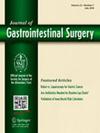胃切除术后内脏肥胖的性别特异性标准与手术部位感染的关系。
IF 2.2
3区 医学
Q3 GASTROENTEROLOGY & HEPATOLOGY
引用次数: 0
摘要
背景:据报道,通过计算机断层扫描(CT)估计的高内脏脂肪面积(VFA)与胃癌(GC)胃切除术患者的手术部位感染(SSI)有关。鉴于脂肪分布因性别而有显著差异,应采用针对性别的内脏性肥胖定义。我们研究了L3水平VFA的最佳性别特异性阈值,以评估胃切除术后SSI的风险。方法:对行根治性胃切除术的828例患者(男564例,女264例)进行研究。Clavien Dindo评分≥2的腹腔内或切口感染并发症被定义为ssi。受试者工作特征(ROC)分析用于确定提取易发生SSI的肥胖患者的最佳性别特异性VFA截止值。我们进行了逻辑回归分析,并计算了修正后的Akaike信息标准(AICc),以比较我们基于性别的基于vfa的标准与传统的基于vfa或基于bmi的标准评估SSI可能性的能力。结果:男性59例,女性16例。最佳VFA阈值为男性119.3 cm2,女性57.2 cm2。多变量分析显示,根据性别特异性标准定义的内脏肥胖是SSI的独立危险因素(优势比:2.74;95%置信区间:1.62-4.66;P < 0.01)。采用我们的性别特异性标准的logistic回归模型得出的AICc(456.4)优于采用传统标准(461.8)或基于bmi(467.0)的肥胖标准。结论:与非性别标准相比,性别特异性标准可提高VFA评估胃切除术后SSI风险的能力。本文章由计算机程序翻译,如有差异,请以英文原文为准。
Association between sex-specific criteria for visceral obesity and surgical site infection after gastrectomy
Background
High visceral fat area (VFA), estimated by computed tomography (CT), is reportedly associated with surgical site infection (SSI) in patients who undergo gastrectomy for gastric cancer (GC). Given that fat distributions vary markedly according to sex, sex-specific definitions of visceral obesity should be applied. This study investigated the optimal sex-specific thresholds for VFA at the L3 level to assess the risk of SSI after gastrectomy.
Methods
This study included 828 patients (564 males and 264 females) who underwent curative gastrectomy. Intra-abdominal or incisional infectious complications with Clavien-Dindo scores ≥ 2 were defined as SSIs. Receiver operating characteristic (ROC) analyses were used to determine the optimal sex-specific VFA cutoffs to extract patients with obesity who are at risk of developing SSI. In addition, logistic regression analyses were performed, and the corrected Akaike information criterion (AICc) was calculated to compare the capability to evaluate the possibility of SSI of our sex-specific VFA-based criteria vs the conventional VFA-based or body mass index (BMI)-based criterion.
Results
SSI developed in 59 males and 16 females. Optimal VFA thresholds were 119.3 cm2 for males and 57.2 cm2 for females. Multivariate analyses revealed visceral obesity, as defined by the sex-specific criteria, to be an independent risk factor for SSI (odds ratio, 2.74; 95% CI, 1.62–4.66; P <.01). The logistic regression model with our sex-specific criteria yielded a better AICc (456.4) than the conventional (461.8) or BMI-based (467.0) criterion for obesity.
Conclusion
Sex-specific criteria can enhance the capability of VFA to assess the risk of SSI after gastrectomy, compared with the non–sex-specific criterion.
求助全文
通过发布文献求助,成功后即可免费获取论文全文。
去求助
来源期刊
CiteScore
5.50
自引率
3.10%
发文量
319
审稿时长
2 months
期刊介绍:
The Journal of Gastrointestinal Surgery is a scholarly, peer-reviewed journal that updates the surgeon on the latest developments in gastrointestinal surgery. The journal includes original articles on surgery of the digestive tract; gastrointestinal images; "How I Do It" articles, subject reviews, book reports, editorial columns, the SSAT Presidential Address, articles by a guest orator, symposia, letters, results of conferences and more. This is the official publication of the Society for Surgery of the Alimentary Tract. The journal functions as an outstanding forum for continuing education in surgery and diseases of the gastrointestinal tract.

 求助内容:
求助内容: 应助结果提醒方式:
应助结果提醒方式:


